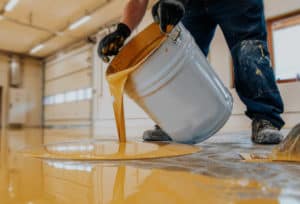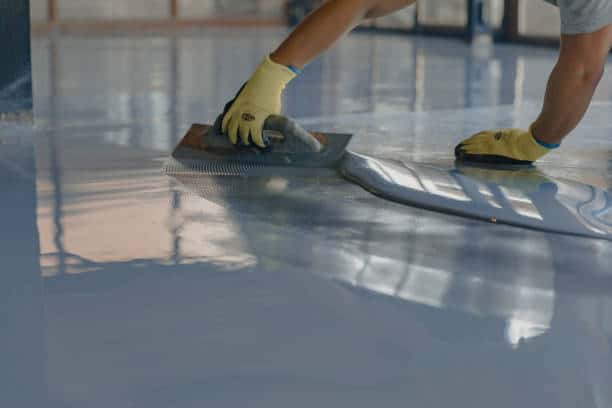Are you planning to get epoxy flooring but racking your brains on why does it cost too much? A wide variety of elements determines epoxy resin flooring prices. Poured resins create an equal, self-leveling surface at a relatively reasonable price per square meter or square foot.
It’s irritating not to know how much your Minnesota epoxy flooring installation will cost. This is why we’re here to tell you about the numerous factors that might affect your epoxy flooring costs.
In order to get a precise and fast estimate for your flooring installation, whether you want to use epoxy or any other form of flooring, you may use our convenient guide.
What Factors Affect the Final Price of Epoxy Flooring?
It doesn’t matter if you are installing the epoxy floor in a home or a business location; many cost factors come into play. The price of your epoxy flooring can be affected by a variety of factors. The following are among them:
1. Amount of Epoxy Resin and Surface Area
The key worry is the area of the floor where epoxy flooring will be installed. Despite the fact that this is the primary technique of calculating costs, there is still a wide range of variations.
Width x Length = Area is a good formula to keep in mind. The length and breadth of a square room are the parameters to be considered while taking measurements. Simply multiply both width and length together.
It’s straightforward math, but it’s critical. Congested residences, for example, may have a smaller floor area available for the installation of poured resin flooring than larger commercial establishments. As a result, less resin is used, and installation costs are decreased eventually.
However, the type of epoxy resin you select might also affect the price. Prices per square meter can vary greatly, from as little as $20 to far over $100 or even more. Costs will, however, be impacted by the size of the installation area, which may or may not be significant.
2. The Complexity and Requirements for Floor Preparation
You may probably get away with installing an epoxy resin floor in an unoccupied business facility, but it is probable that most places where epoxy floors are installed will need some kind of preparation. Cost estimates are heavily dependent on the quality of your current sub-base.
Your resin floor will cost more to install if you have to do additional prep work. In order to effectively prepare, the following steps must be taken:
- Surfaces that have been severely damaged or contain abundant debris make this a time-consuming and difficult operation. On uneven terrain, epoxy flooring can fracture or become uneven if it is installed.
- There are a lot of sealants and protective layers on epoxy resin floors that necessitate a very clean surface. The cost of your installation may be affected if the working area is unusually open or prone to huge volumes of dust.
- Existing vehicle garages, ancient houses, and vast industrial spaces with a lot of dust and other impurities are all possible headaches when preparing the surface for pouring.
3. Epoxy Resin Flooring Type
There are a wide variety of resins to select from, as we said before. In some cases, you may need to have numerous layers of various sorts based on your installation’s specific needs.
For a lower price, you may get poured epoxy flooring in some varieties. In contrast to metallic epoxy, a plain white epoxy will be less expensive. The type of epoxy flooring that you choose for each room or area will depend on how many floors you are installing.
It’s impossible to accurately estimate the cost of any adjustment without doing a thorough study.
4. The Sealants and Layers You’ll Need
Additional resin layers to preserve the surface and prevent damage may raise the price of an epoxy floor if you’re looking for something exceptionally tough and long-lasting.
For example, if you want to keep your floor from corroding, you may need to purchase additional sealants for that purpose.
5. Considerations for Color and Design
The more time and effort it takes to complete your floor, the more you’ll pay. It’s cheaper to use plain white resin because it doesn’t require additional design. Epoxy flooring may be colored in a variety of ways, and dyes can be mixed in during installation before the self-leveling resin is poured. In a variety of colors, this self-leveling resin will provide a flawless finish.
Simple coloring may be done at a reasonable price, but if you want more elaborate finishing and designs, the price will go up. Your installation costs will increase if you use marbled designs or select other more complicated finishes that need a certain level of skill and time to achieve correctly.

6. Any Accessibility Issues and the Difficulty of Installation
Getting to some locations is simply more difficult. You might be considering the basement floor of the home to get epoxy flooring done, or you may be changing the floors on the 20th floor in a commercial building. In any event, the expenses of your project might be considerably impacted by accessibility issues.
If your basement floor is uneven, it may be difficult to transport the essential preparatory equipment and flooring supplies there. The same holds true if this is the situation in a place that is difficult to get to, such as a high floor.
It takes a long time and a lot of effort to move big and cumbersome equipment to inaccessible spots. The cost of your installation will be influenced by factors such as the ease of access and difficulty of installation.
7. Your Installation’s Geographical Location
Urban locations are often more convenient for commuting, easier to transport, and more accommodating for installation demands than rural areas.
If you’re putting epoxy flooring outside, keep in mind that the weather conditions may slow down the installation process, which might increase the overall cost. But with careful planning, this should not be a problem.
Summing Up!
Epoxy flooring’s long-term value should be taken into account while estimating its price. The initial cost of installing an epoxy floor is higher, but the long-term savings for your company much outweigh that. It’s impossible to think of epoxy as pricey when you consider the quality, performance, and protection it provides.
https://media.istockphoto.com/photos/the-worker-applies-gray-epoxy-resin-to-the-new-floor-picture-id1295831125?k=20&m=1295831125&s=612×612&w=0&h=P3GppLGQ7eC5ggwlAB8a1x-ZINnVeaMenwHQa6CqnWc=
https://media.istockphoto.com/photos/worker-applying-a-yellow-epoxy-resin-bucket-on-floor-for-the-final-picture-id1277872367?k=6&m=1277872367&s=612×612&w=0&h=_GxKV3C5lBFU5B0kYmPFHwoMV6kLhBluZDviREwUGyA=

Recent Comments